Religious Zionism
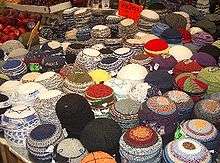
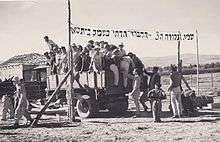
Religious Zionism (Hebrew: צִיּוֹנוּת דָּתִית, translit. Tziyonut Datit, or דָּתִי לְאוּמִּי Dati Leumi "National Religious", or כִּיפָּה סְרוּגָה Kippah seruga, literally "knitted skullcap") is an ideology that combines Zionism and observant Judaism.
Before the establishment of the State of Israel, Religious Zionists were mainly observant Jews who supported Zionist efforts to build a Jewish state in Palestine, or the Land of Israel.
After the Six-Day War and the capture of the West Bank, a territory referred to in Jewish terms as Judea and Samaria, right-wing components of the Religious Zionist movement integrated nationalist revindication and evolved into Neo-Zionism. Their ideology revolves around three pillars: the Land of Israel, the People of Israel, and the Torah of Israel.[1]
History
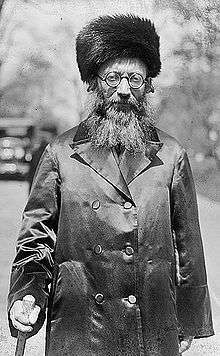
In 1862, German Orthodox Rabbi Zvi Hirsch Kalischer published his tractate Derishat Zion, positing that the salvation of the Jews, promised by the Prophets, can come about only by self-help.[2] Rabbi Moshe Shmuel Glasner was another prominent rabbi who supported Zionism. The main ideologue of modern religious Zionism was Rabbi Abraham Isaac Kook, who justified Zionism according to Jewish law and urged young religious Jews to support efforts to settle the land, and the secular Labour Zionists to give more consideration to Judaism. Kook saw Zionism as a part of a divine scheme which would result in the resettlement of the Jewish people in its homeland. This would bring salvation ("Geula") to Jews, and then to the entire world. After world harmony is achieved by the refoundation of the Jewish homeland, the Messiah will come. Although this has not yet happened, Kook emphasized that it would take time, and that the ultimate redemption happens in stages, often not apparent while happening. In 1924, when Kook became the Ashkenazi Chief Rabbi of Palestine, he tried to reconcile Zionism with Orthodox Judaism.
Ideology
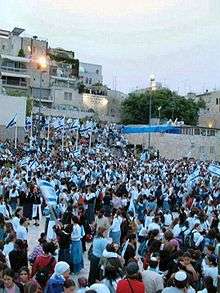
Religious Jews believe that "Eretz Yisrael" (the Land of Israel) was promised to the ancient Israelites by God and the right of the Jews to the land is permanent and inalienable. To generations of diaspora Jews, Jerusalem has been a symbol of the Holy Land and of their return to it, as promised by God in numerous Biblical prophecies. Despite this, many Jews did not embrace Zionism before the 1930s and certain religious groups opposed it then as some groups still do now, on the grounds that an attempt to re-establish Jewish rule in Israel by human agency was blasphemous. Hastening salvation and the coming of the Messiah was considered religiously forbidden, and Zionism was seen as a sign of disbelief in God's power and therefore a rebellion against God. Rabbi Kook developed a theological answer to that claim, which gave Zionism a religious legitimation: "Zionism was not merely a political movement by secular Jews. It was actually a tool of God to promote His divine scheme and to initiate the return of the Jews to their homeland – the land He promised to Abraham, Isaac and Jacob. God wants the children of Israel to return to their home in order to establish a Jewish sovereign state in which Jews could live according to the laws of Torah and Halakha and commit the Mitzvot of Eretz Israel (these are religious commandments which can be performed only in the Land of Israel). Moreover, to cultivate the Land of Israel was a Mitzvah by itself and it should be carried out. Therefore, settling Israel is an obligation of the religious Jews and helping Zionism is actually following God's will."[3]
Religious Jews also disapproved of the Zionists because many were secular Jews or atheists, taking their cue from Marxism. Socialist Zionism envisaged the movement as a tool for building an advanced socialist society in the land of Israel, while solving the problem of antisemitism. The early kibbutz was a communal settlement that focused on national goals unencumbered by religion and precepts of Jewish law such as kashrut. Socialist Zionists were one of the results of a long process of modernisation within the Jewish communities of Europe known as the Haskalah, or Jewish Enlightenment. Rabbi Kook's answer was as follows:
- Secular Zionists may think they do it for political, national or socialist reasons, but in fact – the actual reason for them coming to resettle in Israel is a religious Jewish spark ("Nitzotz") in their soul, planted by God. Without their knowledge, they are contributing to the divine scheme and actually committing a great Mitzvah.
- The role of religious Zionists is to help them to establish a Jewish state and turn the religious spark in them into a great light. They should show them that the real source of Zionism and the longed-for Zion is Judaism and teach them Torah with love and kindness. In the end, they will understand that the laws of Torah are the key to true harmony and a socialist state (not in the Marxist meaning) that will be a light for the nations and bring salvation to the world.
Shlomo Avineri explained the last part of Kook's answer: "... and the end of those pioneers, who scout into the blindness of secularism and atheism, but the treasured light inside them leads them into the path of salvation – their end is that from doing Mitzva without purpose, they will do Mitzva with a purpose." (page 222, 1)
Organizations
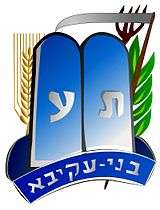
The first rabbis to support Zionism were Yehuda Shlomo Alkalai and Zvi Hirsch Kalischer. They argued that the change in the status of Western Europe's Jews following emancipation was the first step toward redemption (גאולה) and that therefore one must hasten the messianic salvation by a natural salvation — whose main pillars are the Kibbutz Galuyot ("Gathering of the Exiles"), the return to Eretz Israel, agricultural work (עבודת אדמה) and the revival of the everyday use of the Hebrew language.
The Mizrachi organization was established in 1902 in Vilna at a world conference of religious Zionists. It operates a youth movement, Bnei Akiva, which was founded in 1929. Mizrachi believes that the Torah should be at the centre of Zionism, a sentiment expressed in the Mizrachi Zionist slogan Am Yisrael B'Eretz Yisrael al pi Torat Yisrael ("The people of Israel in the land of Israel according to the Torah of Israel"). It also sees Jewish nationalism as a tool for achieving religious objectives. Mizrachi was the first official religious Zionist party. It also built a network of religious schools that exist to this day.
In 1937–1948, the Religious Kibbutz Movement established three settlement blocs of three kibbutzim each. The first was in the Beit Shean Valley, the second was in the Hebron mountains south of Bethlehem (known as Gush Etzion), and the third was in the western Negev. Kibbutz Yavne was founded in the center of the country as the core of a fourth bloc that came into being after the establishment of the state.[4]
Political parties
The Labor Movement wing of Religious Zionism, founded in 1921 under the Zionist slogan "Torah va'Avodah" (Torah and Labor), it was called Hapoel Hamizrachi. It represented religiously traditional Labour Zionists, both in Europe and in the Land of Israel where it represented religious Jews in the Histadrut. In 1956, Mizrachi, Hapoel HaMizrachi, and other religious Zionists formed the National Religious Party to advance the rights of religious Zionist Jews in Israel. Other parties and groups affiliated with religious Zionism are Gush Emunim, Tkuma, and Meimad. A radical branch of Religious Zionism, Kahanism, was founded by Rabbi Meir Kahane, whose party, Kach, was eventually banned for racism. Today, Hazit is the leading wing of this school of thought.
Educational institutions
The flagship religious institution of the religious Zionist movement is the yeshiva founded by Rabbi Abraham Isaac Kook, called in his honor "Mercaz haRav" (lit. the Rabbi's center). Other religious Zionist institutions are Yeshivat Or Etzion (founded by Rav Haim Druckman, a foremost disciple of Rabbi Tzvi Yehuda Kook), Yeshivat Machon Meir, Yeshivat Har Etzion, Yeshivat HaKotel, Yeshivat Birkat Moshe in Maale Adumim, Yeshivat Har Bracha, Yeshivat Har Hamor, Ein HaNatziv Women's Seminary, and the Yaacov Herzog Institute for Jewish Studies.
Dress
Religious Zionists are often called Kippot sruggot, referring to the knitted or crocheted skullcaps (Hebrew kippa, pl. kippot) worn by the men. However, there are also some religious Zionists who wear other types of headcoverings (black velvet kippot, for example).
Newspapers
Some Religious Zionist newspapers censor images of females.[5]
Politics
Most religious Zionists embrace right-wing politics, especially the religious right-wing Jewish Home, but they also support the mainstream right-wing Likud. There are also left-wing religious Zionists, such as Rabbi Michael Melchior, whose views were represented by the Meimad party (which ran together with the Israeli Labor party). Many Israeli settlers in the West Bank are religious Zionists, along with most of the settlers forcibly expelled from the Gaza Strip in August and September 2005. However, others move to the West Bank for economic reasons, particularly new immigrants such as those from the FSU who cannot afford the cost of living in cities such as Tel Aviv.
Military service
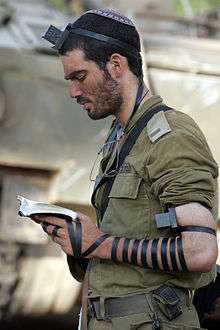
Religious Jews in Israel are obligated to serve mandatory service in the IDF, like all other adult Jewish males in Israeli society. Certain segments of Orthodoxy defer their service in order to engage in full-time Torah study. Religious Zionist thought advocates that both are critical to Jewish survival and prosperity.
For this reason, many religious Zionist men take part in the Hesder program, whereby they are able to combine military service with yeshiva studies. Others attend a pre-army Mechina educational program, delaying their service by one year. 88% of Hesder students belong to combat units, compared to a national average of below 30%. In November 2010 the IDF held a special conference which was attended by the heads of Religious Zionism in order to encourage female religious Zionists to join the IDF. The IDF promised it would make sure that all modesty and kosher issues will be handled in order to make female religious Zionists comfortable.
While some religious Zionist women serve in the army, most choose national service, known as Sherut Leumi, instead (working at hospitals, schools and day-care centers).
Notable figures
- Yehuda Amital
- Shlomo Aviner
- Naftali Bennett
- Yosef Burg
- She'ar Yashuv Cohen
- Rabbi Chaim Druckman
- Effi Eitam
- Mordechai Eliyahu
- Meir Kahane
- Zvi Yehuda Kook
- Dov Lior
- Zevulun Orlev
- Shlomo Riskin
- Avraham Shapira
See also
- Christian Zionism
- Haredim and Zionism
- Modern Orthodox Judaism
- Religion in Israel
- Atchalta De'Geulah
- Arutz Sheva
- Hardal
- Hesder
- Machon Meir
- Mamlachti dati
- Torato Omanuto
References
- ↑ Adriana Kemp, Israelis in Conflict: Hegemonies, Identities and Challenges, Sussex Academic Press, 2004, pp.314–315.
- ↑ Zvi Hirsch Kalischer (Jewish Encyclopedia)
- ↑ Samson, David; Tzvi Fishman (1991). Torat Eretz Yisrael. Jerusalem: Torat Eretz Yisrael Publications.
- ↑ "Settlement clustering on a socio-cultural basis: The bloc settlement policy of the Religious Kibbutz Movement in Palestine," Yossi Katz, Journal of Rural Studies, vol. 11, no. 2, pp.161–171, 1995
- ↑ "ביטאון ש"ס צנזר את תמונת רחל אטיאס". 7 June 2012 – via Ynet.
Bibliography
- The Zionist Idea and Its Variations by Shlomo Avineri, Am Oved publishing, chapter 17: "Rabbi Kook – the dialection in salvation"
External links
| Wikisource has original text related to this article: |
| Wikimedia Commons has media related to Religious Zionism. |
- Religious Zionists of America
- Poster of Historic Religious Zionist Leaders
- A Historical Look at Religious Zionism by Prof. Dan Michman
- Original Letters and Manuscripts: Zionism, Ben-Gurion on God's Promises Shapell Manuscript Foundation
- "Kipa – House of Religious Zionism" (Hebrew)
- Official National Religious Party website (in English)
- Religious Zionism And Modern Orthodoxy, Rav Yosef Blau
- Modern Orthodoxy vs. Religious Zionism; are they the same thing? Rabbi Yair Spitz
- Orthodox Zionism, Prof. Eliezer Segal
- Religious Zionism, Compromise or Ideal?, hagshama.org.il
- Religious Zionism: Between Openness and Closedness, Prof. Avi Saguy
- The American Friends of YBA – Supporters of religious Zionist educational movement in Israel